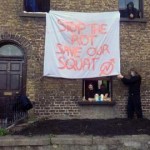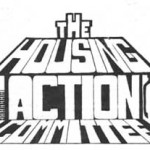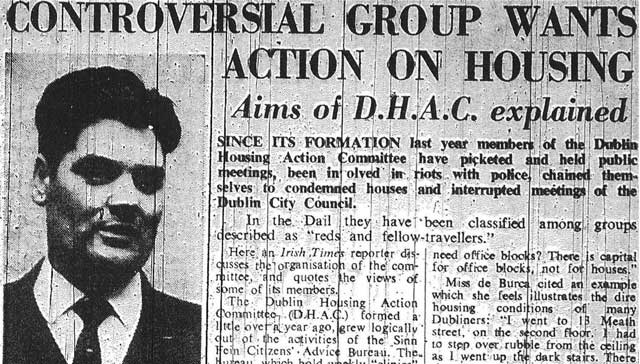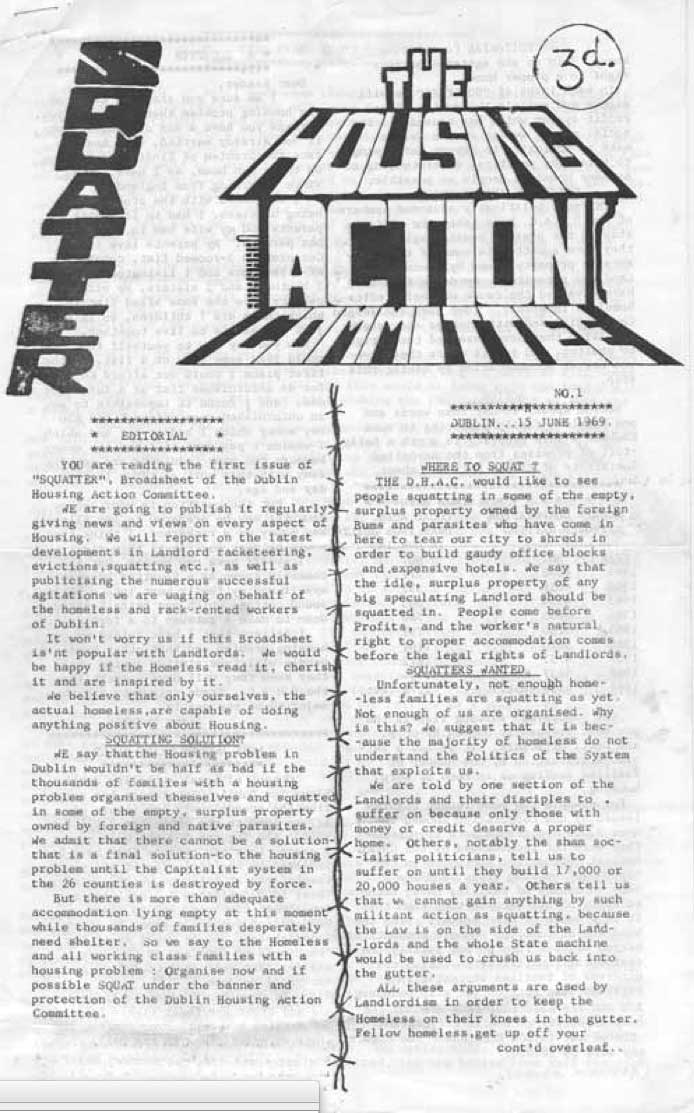October 19th: European Day of Action for Housing
Dublin: Successful anti-eviction defence
Around lunchtime on April 15th we received word that there was an anti-eviction protest underway on Manor street in Dublin outside a house that had been squatted. A Garda had called at the door that morning and after being refused entrance had said he’d be back later with more Garda. The building had been squatted on and off a couple of times in recent years and was recently re-occupied.
[Read More]
Dublin: Squatting, Urban Politics & the Dublin Housing Action Committee, 1968-71
The contemporary crisis of capitalism has made markedly visible the relationship between finance capital and property speculation, between the concentrated money-power of bankers and speculators and the shaping of the built environment in our towns and cities.
This relationship has had all manner of disastrous consequences for the working class (inflated rents or mortgages, lower living standards, ghettoisation and suburbanisation etc.) and for the environment (distorted flood plains, abandoned buildings, the prioritisation of car commuting over public transport etc.). Today, it seems that one of the real challenges for the working class is to change that relationship, to claim a ‘right to the city’ for its inhabitants.[1] Dublin, as it turns out, has quite a significant heritage of anti-capitalist urban politics of precisely this sort, notably the Housing Action campaign of the late 1960s. Given that this kind of activism is beginning to re-emerge – Unlock NAMA being a recent example – it might be useful to assess that history.
The political economy of Dublin’s urbanisation
Owing to decades of state-assisted slum landlordism, housing conditions for Dublin’s working class were notoriously bad throughout the early twentieth century. In the 1960s, however, a number of factors combined to make the chronic acute. Austerity cutbacks on housing provision in the 1950s combined with population increases in the 1960s to pressure the state’s available housing resources. (Some 10,000 applicants waited on Dublin Corporation’s ‘approved’ housing list;
an equivalent number waited off it). At the same time, inner-city tenements were collapsing, resulting in numerous fatalities. The Fianna Fáil government’s immediate response was to condemn the buildings and to compel several hundred families to be re-housed in suburbs without social amenities or public transportation. This fitted a broader urbanisation process whereby Dublin’s working class were to be suburbanised and the city centre adapted for offices, retail and car parking spaces. [2] Given the extent of housing waiting lists, however, the government’s attempts to clear tenement residents triggered an intense political campaign. In May, 1967, left-leaning members of Sinn Féin (predecessors of the Workers Party) established the Dublin Housing Action Committee (DHAC), which soon expanded to include a range of left- wing organisations, including the Irish Communist Organisation, Labour party branches, Connolly Youth, trade unionists and a variety of local housing groups such as the Ballymun Tenants’ Association and the Dublin Flat-dwellers’ Association.
The DHAC combined building voluntary networks of the homeless with holding prominent, public demonstrations aimed at publicising demands for social housing. Initially, the DHAC picketed Dublin Corporation meetings to call for more housing. By September 1968, however, the Committee had moved to direct action, organising homeless families to squat vacant property. Throughout 1968 and 1969 the DHAC contested office developments such as those in Mount Street and helped the homeless resist evictions. Its publication, The Squatter, disseminated information on suitable locations. Similar organising models were adopted by Housing Action Committees in Derry and Cork. [3] The DHAC, like the DUA before them, appealed to a combination of direct action, civil disobedience and moral force. Alternative interpretations of the constitution – notably the priority of the rights of the family over the rights of property – featured prominently in their legal and public defence. When the legal system continued to serve injunctions against the DHAC, it responded by challenging the justice system.
Wave of protest
Of all the DHAC squatters taken to the High Court, the most high profile was perhaps Dennis Dennehy. During the summer of 1968, Dennehy, a meber of the Irish Communist Organisation, squatted with his wife, Máire, and children at 20 Mountjoy Square, the property of landlord, Ivor Underwood. [4] Up to that point, the family had been living in a leaking caravan with the children ‘shivering at the side of the road’.[5] Local residents had previously signed a petition demanding that the square be rebuilt as working-class housing (not as offices or gentrified, single-family dwellings), and marched to the Custom House to raise awareness of the city’s housing shortages. When Underwood sold a number of houses on Mountjoy Square to a development company, slogans denouncing the sale were painted on the walls of his Dalkey residence and his car was damaged by a home-made pipe-bomb.[6] Although the Dennehy family offered to pay rent, the landlord refused and subsequently sought an injunction to restrain them from occupying the premises. Dennehy was subsequently imprisoned for failing to comply with the order.[7]
The imprisonment of DHAC members focussed media attention on the state’s housing policy and ignited popular discontent at housing shortages. When Denis Dennehy went on hunger strike, a wave of protest erupted across Dublin. Public meetings took place outside the GPO where nightly marches would set off for Mountjoy prison to support imprisoned squatters. Hundreds also took part in regular sit-down protests at O’Connell Bridge. Joseph Clarke, a veteran of the 1916 Rising, interrupted State celebrations in the Mansion House commemorating the fiftieth anniversary of the first Dáil to protest Dennehy’s treatment. As security guards carried Clarke outside, students greeted them with banners proclaiming ‘Evictions: English landlords, 1868; Irish landlords, 1968- 69’. People’s Democracy, en route from Belfast to the GPO as part of its campaign for civil rights for Northern Ireland’s Catholic minority, held a meeting of 800 people outside Dennis Dennehy’s squat at 20 Mountjoy Square to protest about the housing situation on both sides of the border. The Dublin Trades Council passed a resolution calling for street demonstrations by trade unionists. Dennehy was eventually released and found housing. Undeterred, he supported a more extensive campaign of squatting.
These protests aimed at foregrounding the judiciary’s complicity with the property-owning class. In September 1969, five members of the DHAC (three women and two men) occupied the Four Courts in Dublin.[8] The group arrived at 11am and announced that they had an appointment to see a senior counsel. When they found the Master’s Court vacant, they barricaded the door with furniture and then painted a sign on a window blind overlooking Inn’s Quay proclaiming: ‘DHAC. We are occupying the Four Courts to demand the release of jailed homeless’. The object of the demonstration was to protest at the imprisonment of Patrick Brady and Patrick Geraghty for refusing to vacate a squat at the Carlton Hotel, Harcourt Street. Seán Dunne, vice-chairman of the DHAC, claimed that Brady and Geraghty were being treated as criminals and that their food had been cut off when they complained about the prison’s ‘atrocious conditions’. At 1pm a force of twenty gardaí arrived, cleared photographers and reporters from the corridors and broke down the barricade.[9]
Despite the Four Courts group making it clear that their protest was peaceful, that no damage had been done to property and that no resistance was contemplated, the gardaí beat and kicked them around the room. Eric Fleming and Isolda Byrne claimed they were forced to sit on the floor while gardaí kicked them in the head and mouth. The DHAC insisted it was not ‘anti-police’, citing as proof their helping a Garda widow threatened with eviction from her home of 35 years.[10]
Repression
Various protests and squats across the city typically met with a violent state response. Hilary Boyle, a seventy year old social justice campaigner, described how the gardaí charged at one such march ‘like mad bulls…They hit out with their batons, they kicked and punched and generally acted as agent provocateurs’. As the conflict in Northern Ireland escalated, the government introduced a raft of ‘law and order’ measures, some of which aimed at breaking the DHAC. The Prohibition of Forcible Entry and Occupation Act (1971) changed squatting from a civil to a criminal offence and, furthermore, made its public endorsement illegal. Throughout 1971, a diverse coalition attempted to oppose the legislation, including Citizens for Civil Liberties, the National Association of Tenant Organisations, the Union of Students of Ireland, Labour party branches and the Irish Congress of Trade Unions.[11] sixty-five RTÉ workers signed a petition opposing the Bill on the grounds that it permitted one-sided media coverage only. Some forty gardaí prevented a group of protestors from going beyond the gates of Leinster House to lobby politicians directly, the first time in the history of the State that this had occurred.[12]
By this stage, however, the anti-squat legislation was almost unnecessary: Dublin Corporation’s “crowbar brigades” were ejecting people daily without recourse to the law. These evictions came as the DHAC was fracturing under the pressures of its own internal politics, largely centring on how members interpreted and responded to the Northern Ireland conflict. However, in a large number of cases, the DHAC had succeeded in negotiating on behalf of tenants with Dublin Corporation and pri-
vate landlords, a number of whom, unwilling to be publically shamed by protests, accepted squatters as legal tenants.[13] Members of the DHAC identi- fied their primary achievement as one of deeper politicisation. Speaking of the thirty or so families she had encouraged to occupy empty houses to defy the law, Máirín de Búrca observed: ‘They won’t ever lie down again and accept whatever the law says if they think the law is unjust’.
Urban Politics: Then and Now
Urban campaigns adopting popular direct action re-emerged in later years, notably the Dublin Squatters’ Association of the 1970s and the Coalition of Communities against Drugs of the 1980s and 1990s.[14] During the boom years, notwithstanding the persistence of unequal and often dire living conditions, the state succeededin incorporating civil society energies from these urban centres, primarily through social partnership mechanisms. Meanwhile, successive governments encouraged banks, speculators and developers to make out like bandits through ‘public private partnerships’, maximising profits at the expense of inner-city living conditions. Of these PPPs’ spectacular unfairness, the abysmal failure to re-develop O’Devaney Gardens on Dublin’s North Circular Road is emblematic.[15] The contemporary crisis demonstrates how this toxic collaboration operated on an even larger geographical scale.
Following the property crash, the commuter belts of Dublin, Cork and Galway are daily emerging as regions haunted by ghost estates, negative equity and escalating mortgage arrears. In the coming decade, exorcising these demons is likely to be pivotal to all forms of politics in Ireland. Unlike younger, mortgage-less people currently fleeing Ireland in droves, populations in these areas are more closely tied by mortgage and family commitments to the island and its political system.[16]
Admittedly, the demands of private homeowners are not traditionally associated with radical politics. Nevertheless, as David Harvey argues, there are grounds for social movements and progressive groups to take seriously the possibility of contesting the politics of the built environment as opposed to fighting around sectional interests or single issues. If such a politics were to take organisational form, the Dublin Housing Action Committee would approximate a good working model of direct action and co-operative practice that communities, left political parties and non-aligned activists could aspire to.
WORDS: Tom Murray
Squatter: No. 1 publication from Dublin Housing Action Committee, 1969
This article is from Irish Anarchist Review no7 – Spring 2013
References:
[1] See David Harvey, 2012, Rebel Cities.
[2] Conor McCabe, 2011, Sins of the Father, pp.31-32.
[3] ‘Gardai hurt in street row in Cork’ in Irish Times, 17.02.1969.
[4] From the 1960s onwards, Ivor Underwood built up a portfolio of Dublin properties, including some 70 Georgian houses, leaving an estate of EUR 69m on his death in the 2000s. ‘Ireland’s Rich List: No. 176’ in Irish Independent, 31.03.2010.
[5] ‘Judge orders family to leave house’ in Irish Times, 26.11.1968
[6] ‘Explosion damages car outside home’ in Irish Times, 09.10.1968.
[7] ‘Landlord seeks to restrain occupiers’ in Irish Times, 23.11.1968. ‘Judge orders family to leave house’ in Irish Times, 26.11.1968.
[8] ‘Protestors forced from Four Courts’ in Irish Times, 26.09.1969.
[9] ‘Housing Group seeks inquiry into police attitude at Four Courts’ in the Irish Times, 27.09.1969.
[10] ‘Housing Group seeks inquiry into police attitude at Four Courts’ in the Irish Times, 27.09.1969.
[11] ‘Demand for Axing Anti-Squat Bill’ in Irish Times, 02.03.1971.
[12] ‘40 gardai curtail Dail lobby’ in Irish Times, 24.02.1971.
[13] Mary Maher, ‘The Making of a Revolutionary’ in Irish Times, 19.01.1970.
[14] Alan MacSimoin on ‘The hidden history of squatting in Ireland’; http://struggle.ws/ws/squat48.html . See Aoifer Fisher, ‘Review of Andre Lyder’s “Pushers Out: The inside story of Dublin’s anti-drugs movement”. http://struggle. ws/wsm/ws/2005/89/drugs.html
[15] The property developer in this PPP was Ber- nard McNamara. Christine Bohan, ‘After more than 15 years, plans for O’Devaney Gardens officially scrapped’ http://www.thejournal.ie/o-devaney- gardens-scrapped-694646-Dec2012/
[16] Since 2007, Irish property prices have fallen by some 50-70%. As of 2012, Irish citizens carried the largest mortgage debt per head of population in the world while at least 40% of all Irish households were in negative equity and some 10% are in mortgage arrears of more than three months. See also Morgan Kelly ‘If you thought the bank bailout was bad, wait until the mortgage defaults hit home’ in Irish Times, 16.11.2010.
Source: http://www.wsm.ie/c/squatting-politics-dublin-housing-action-committee
The hidden history of squatting in Ireland (1976-1996)
TWENTY YEARS ago Dublin Corporation was forced to give tenancies of hundreds of squatters. Those people got themselves housed, not by pleading with politicians, but through direct action. Alan MacSimoin, who was one of the organisers of Dublin Squatters Association, remembers how they did it.
In 1976 there were several hundred families squatting in local authority flats in the Corporation area. Waiting lists were long and increasing numbers were housing themselves in flats which had become vacant or were due for rehabilitation work.
Evictions were common, with most being put out within a few months of squatting. Nobody was jailed or even prosecuted under the Forcible Entry and Occupation Act as this would have been politically embarrassing for local councillors. In the private sector, however, there had been jailings. So what usually happened was that after being evicted families would squat another flat. And this process would repeat itself again and again.
The Williams family in Dolphin House, a large south inner city complex, were served with an eviction order. The offer made by the Housing Department was the Legion of Mary hostel for the wife and child, nothing for the husband. They decided to resist.
An information picket was held outside the local rent office and we also went door-to-door in Dolphin House, where there are 400 flats, asking people to help. On the morning of the eviction we went around with a megaphone asking the locals to stand with the Williams family. By the time the sheriff, his bailiffs and the cops turned up we had 400 locals blocking the landing, stairwell and courtyard. It was amazing.
Dublin: The Plight of Carrickmines castle
Since August 30th this year the site of the 800 year-old castle has been occupied by a group of activists known as the “Carrickminders.” They are there in an attempt to stop the extension of the M50 with inclusion of a roundabout that will almost totally obliterate and eventually condemn to memory the site, which is of vast archaeological significance. To date over 30,000 artifacts have been discovered there. Following the original excavation which was forcibly ended on August 30th (upon which the Carrickminders stepped in) certain of the 130 archaeologists were taken from the pits crying over the amount uncovered and that would be left there to be destroyed by the building of the road. [Read More]





